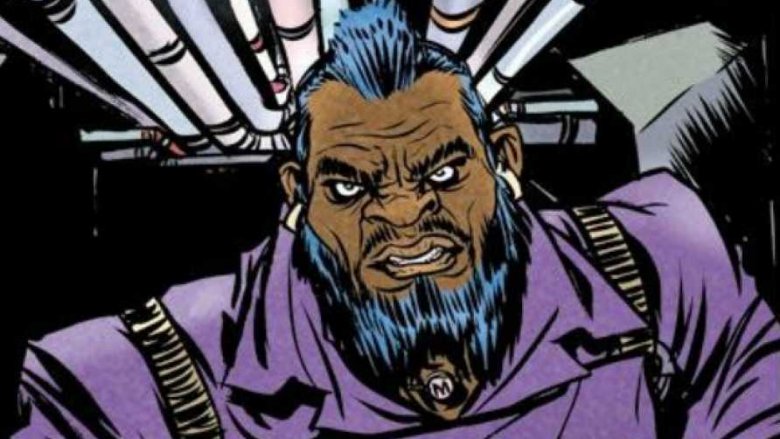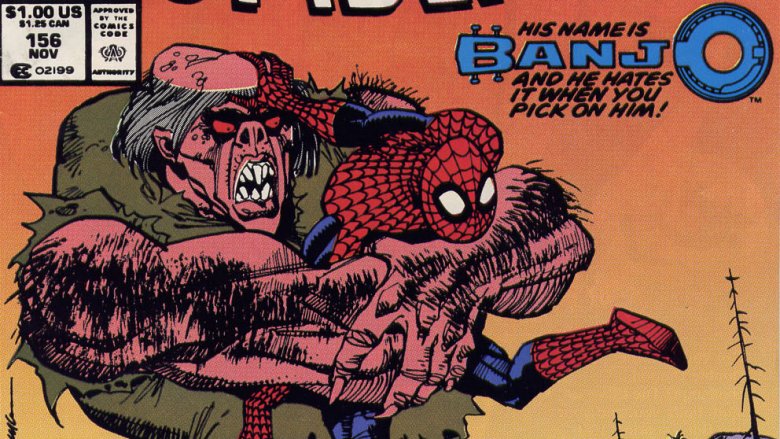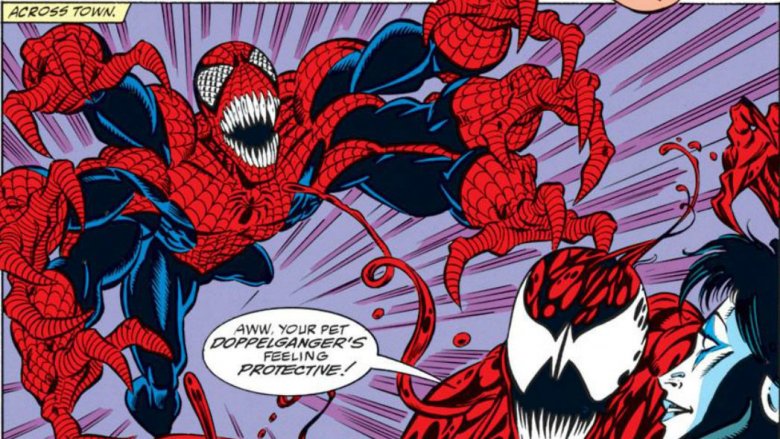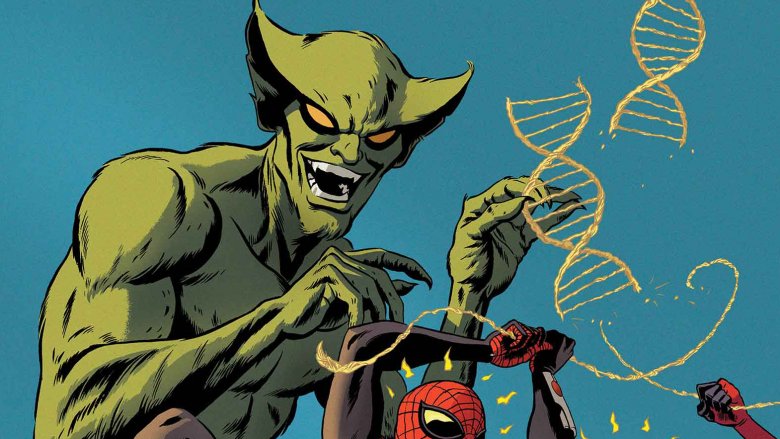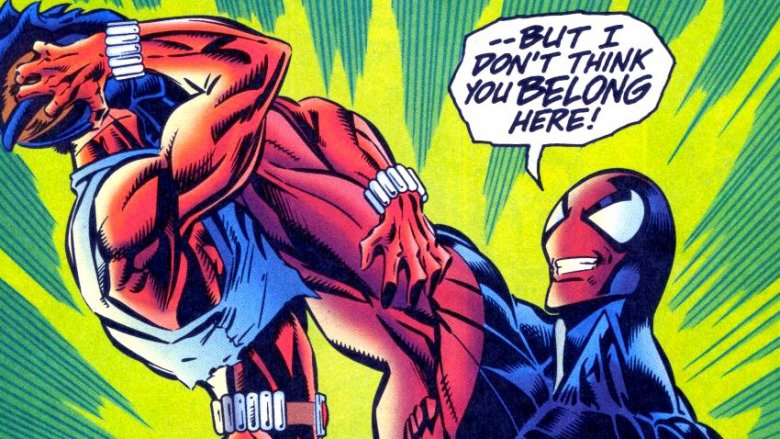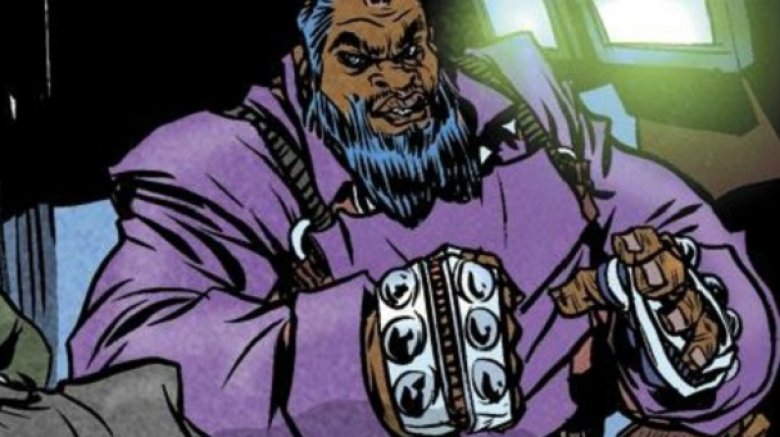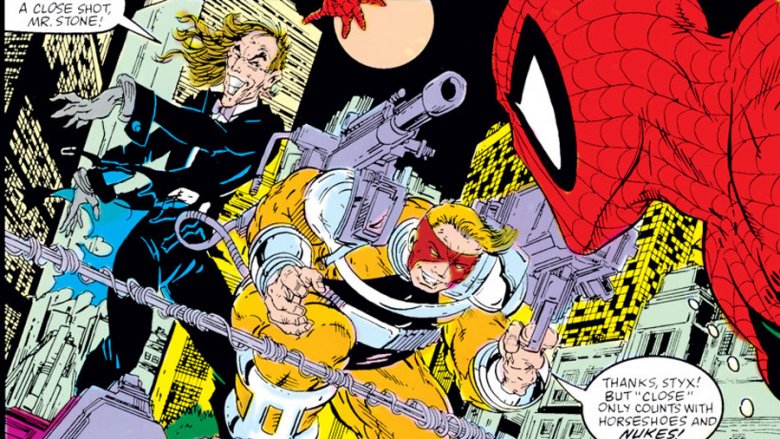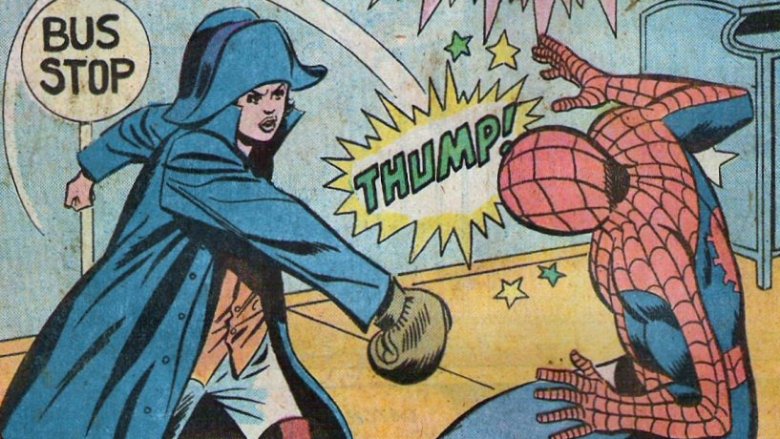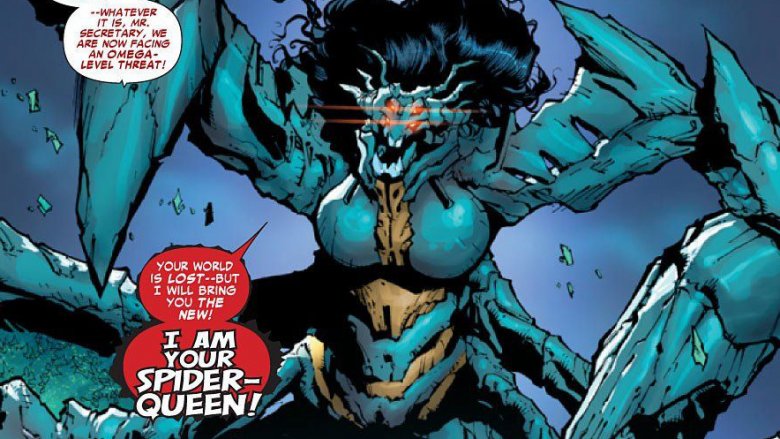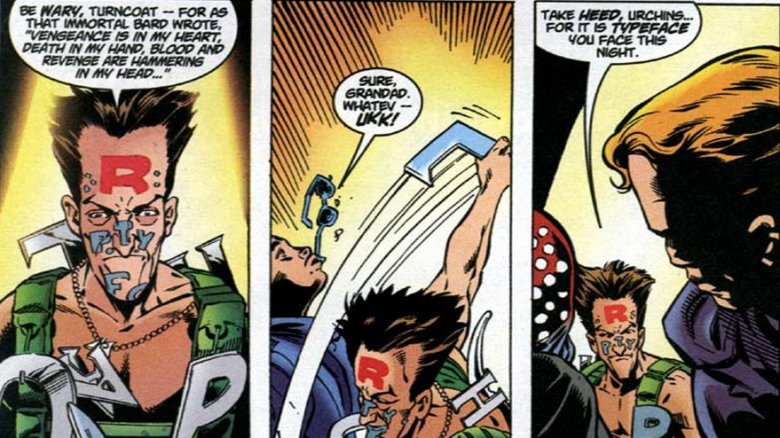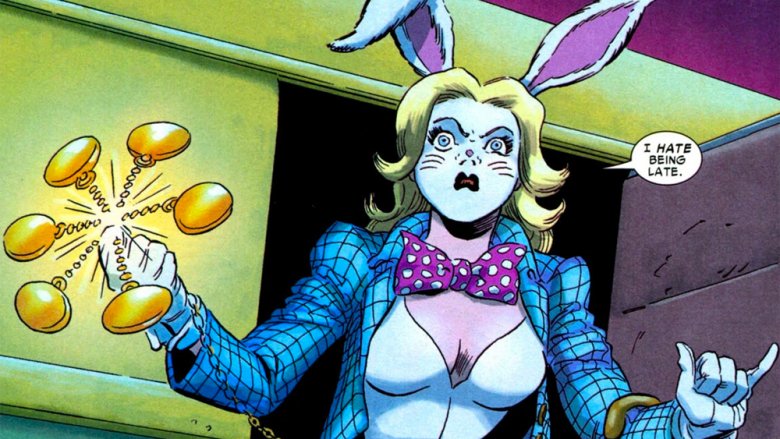The Dumbest Spider-Man Villains Of All Time
No matter what standard you're using to judge them, Spider-Man's enemies are some of the greatest villains in comic book history. There's the Green Goblin, a sinister industrialist who committed one of the only permanent murders in the history of comics and changed superhero stories forever. And then there's Carnage, a serial killer whose madness was only multiplied by an alien symbiote that gave him the ability to take his bloody mayhem to new heights. And don't forget Doctor Octopus, a scientist as brilliant as he is deadly, whose silly name masks a history of devastating master plans. Yeah, that's one impressive rogues' gallery right there.
Unfortunately, Spidey's villain roster is also one of the largest, and that means there's plenty of room for some truly stupid characters alongside those iconic bad guys. Some of them have their own unique charm, like Swarm (a Nazi made of bees) and the Big Wheel (a big wheel), but for the others, there's almost no hope of redemption. Here are the dumbest Spider-Man villains of all time.
Banjo hates it when you pick on him ... so let's pick on him
There's a long, proud tradition of Spider-Man villains who show up for exactly one issue, cause a little bit of trouble, and then vanish into the ether, never to be seen again. Among those forgettable foes, none of them are dumber or less memorable than Banjo, the terror of Appalachian Pennsylvania.
Banjo made his first and only appearance in Spectacular Spider-Man #156, serving as a single-issue speed bump during a long-running story about a much more important villain, Tombstone. The short version is that he's a radioactive hillbilly mutant with the powers of super-strength and an incredibly thick accent that leads him to say things like, "Yew think yew can hurt me like yew people used to, but yew can't! Ah've grown big!" See, his mother was caught in the fallout of the Three Mile Island disaster while she was pregnant and "livin' with my cousin downriver" (not exactly the most subtle subtext there). As a result, she gave birth to two mutated boys who grew up in an isolated holler in the mountains. Banjo got the misshapen form and physical strength, while his brother Abner, also known as Bugeye, got the ability to give his enemies "brain fever" with his psychic powers.
What's really amazing about Banjo is that while he obviously wasn't going to stick around and join the Sinister Six, someone at Marvel saw fit to give him his own custom logo on the cover, like he was ready to spin off into his own ongoing adventures. Just for comparison here, the Green Goblin wouldn't get his own logo until the '90s, and Doc Ock still doesn't have one.
Doppelganger is one of Spider-Man's worst villains
Not every terrible villain is doomed to obscurity. Some of them manage to stick around way longer than anyone would ever expect them to, despite the fact that they make no sense at all.
For example, there's Doppelganger, one of the few duplicates of Spider-Man that wasn't a clone. Instead, he had his origins in Infinity War (the '90s comic book crossover, not the 2018 movie). The whole thing is pretty complicated, but the relevant part here is that at one point, all of the Marvel heroes involved had to fight twisted, demonic versions of themselves that were weirdly exaggerated in a Satanic funhouse mirror sort of way. There was a version of Wolverine with extra-long adamantium fingernails, for example, and a fanged Captain America who carried a giant buzzsaw blade instead of a shield, and fought the real Captain America while the Real Cap was momentarily a werewolf. Comics in the '90s were great.
Spider-Man's double, who eventually just took the name "Doppelganger," had the requisite fangs, along with multifaceted bug eyes and six arms, so no one was in danger of confusing him for his heroic counterpart. For some reason, he was the only one to stick around after Infinity War, and while there's a good chance that he would've been quickly forgotten, he wound up being one of the many villains featured in Maximum Carnage, one of the biggest and most popular Spider-Man stories of the decade. The weirdest part? Thanks to his mindless nature, Doppelganger was treated as Carnage and Shriek's baby in this weird roleplaying fantasy where they pretended to be married. Like we said, comics in the '90s were great ... but they were also really weird.
The Jackal is a messed-up monster
While we're on the subject of duplicate Spider-Men and characters who've stuck around way longer than anyone ever wanted them to, no list of the worst Spider-Foes would be complete without Miles Warren, the Jackal. That dude is, in every way, a straight-up creep.
At one time, he was Peter Parker's science professor at Empire State University, and it was there he developed a very unsavory obsession with one of his other students, Gwen Stacy. Once Gwen died, Warren decided to get into cloning and make his own Gwen to do, uh, stuff with. Along the way, he discovered that Peter was Spider-Man and started cloning him, too, and decided to style himself as a supervillain called the Jackal by wearing a skin-tight, bright green fursuit with tiny blue shorts. Just for the record, that is not what jackals look like, so yeah ... that is almost definitely a sex thing.
Along with his creepier exploits, the Jackal is also responsible for the creation of Ben Reilly, the original Spider-Man clone who used to fight crime in a hoodie with the sleeves cut off, and who mistakenly discovered that he was the "real" Spider-Man and then kicked Peter and Mary Jane out of their own comics for about a year. Jackal also has a tendency to create clones that literally ruin everything they touch, which is interesting, because that's what the Jackal himself does to any story he shows up in.
Spidercide is so, so stupid
If you ever want to see what a hollow-eyed "thousand-yard stare" looks like, just walk up to anyone who was reading Spider-Man comics in the '90s and casually mention the word "clone." For years, clones were the driving focus of the entire Spider-Man franchise, a dark time that saw not only a debate about who was the "real" Spider-Man, but a series of increasingly improbable clones.
Along with Spider-Man's "brother," Ben Reilly, the "Clone Saga" also introduced Kaine, a serial killer Spider-Man with long hair who basically used his sticky spider-powers to burn people's faces off. That's weird, but believe it or not, he's not the worst Spider-Clone. Instead, that honor goes to Spidercide. The Jackal created him specifically to eliminate all the other Peter Parkers that were running around, telling him to "commit mass spider-cide" before deciding this would be a good name.
In addition to the standard issue strength and stickiness, Spidercide also had shape-shifting powers, because when there are five or six other guys running around who are literally just you, you need a little something to set yourself apart. We guess turning your hands into knives is as good as anything else.
Let's erase Manslaughter Marsdale from our memories
The cover for Amazing Spider-Man #271 advertises that "mayhem is a man called Manslaughter," and in theory, that's a pretty exciting blurb. In practice, however, "mayhem" in this case means that the bad guy lands exactly one punch before Spider-Man effortlessly beats the living bejeezus out of him and sends him packing to the most obscure footnoes in the Official Handbook of the Marvel Universe.
The real focus of the issue is Crusher Hogan, the wrestler that Spider-Man tested his powers on all the way back in Amazing Fantasy #15, his first appearance. It turned out that in the intervening years, Crusher — whose humiliating defeat at the hands of a scrawny teenager with the proportionate strength of a spider led him to take a job sweeping up at a boxing gym — had slightly exaggerated his relationship to the superhero. He not only claimed to have trained Spider-Man after their five-minute bout, but even told the younger fighters that he invented Spidey's web-shooters and gave him his first costume. As you might expect, nobody really believed him, including the gym's owner, Manslaughter Marsdale, who intimidated the boxers into signing unfair contracts and fixed fights for his own gain.
Spidey was nice enough to go along with Crusher's stories after he accidentally stumbled across the problem, but first, he had to deal with Marsdale. It seemed like Marsdale might present a challenge, since he had a pretty dubious "power" thanks to the fact that he had "operation a few years back to block the pain ... all the pain!" The thing about not being able to feel pain, though, is that it really just keeps you from noticing that your body is being hurt. It doesn't prevent Spider-Man from knocking you out by punching you so hard that you crash through a wall.
Styx and Stone are incredibly silly Spider-Man villains
Styx and Stone are the ultimate examples of coming up with the name first and then trying to figure out how to make a character later. There's not really anything wrong with that, but with these two, it definitely seems like somebody thought the name was so strong that they could phone in the rest of it, but only got halfway through before heading out to lunch. Styx, named for the river in Greek mythology that carries souls to the land of the dead, has the power to cause instant death for anyone he touches. On top of that, he experiences a euphoric moment of bliss whenever he does so.
Stone is ... a guy who's also there.
Okay, so it's slightly more complicated than that. Gerald Stone was a scientist who did some experiments on Styx, accidentally gave him his orgasmic death powers, and then felt really bad about it. In order to fund research into a cure, he and Styx became mercenaries, presumably because he didn't feel so bad about it that he wouldn't use Styx to get some money. Admittedly, mercenary work is probably one of the better career options when your entire marketable skillset is knowing a dude who can kill someone by tapping them on the forehead, like the guy in the Bone Thugs-n-Harmony's "Crossroads" video.
Want to know the best part about all this? Since it's pretty easy to foil someone with a death touch by just staying about three feet away from them, Styx has the secondary power of having really, really stretchy fingers.
The Thumper is one of Spider-Man's most ridiculous rogues
Back in the '70s, Spider-Man appeared in live-action skits on The Electric Company, an educational TV show that was meant for kids who'd grown slightly too old for Sesame Street. To go along with it, Marvel published Spidey Super-Stories, a lighthearted series that was designed to be easy to read, with short sentences and small words, and frequently contained some of the most bizarre comics ever published. The one where Doctor Doom mashes up the two most popular movies of the late '70s into "Star Jaws" and makes a giant space station that eats the entire Earth in one bite, for instance, is well worth checking out.
In addition to regular Marvel villains like Doom and Thanos (who had a helicopter with his name written on it in this comic), the series also featured some lower-rent villans. Given the book's nature, it's almost cheating to pull them out for this list, but there's one of them who's just so mind-boggling that she deserves a mention: the Thumper.
Here's her backstory, as printed in the comic: "When the Thumper didn't get a yellow pony for her birthday, she got very angry and turned to crime. Dressed as the great French hero Napoleon, the Thumper looks for someone to thump." That's it, and that's amazing. Spider-Man eventually defeats her by webbing her up, putting her on a yellow rocking horse, and then leaving her happily rocking for the cops to deal with.
Spider-Queen is an eight-legged monstrosity
Unlike most of the characters on this list, Adriana Soria is a relatively recent creation, first showing up back in 2004. That doesn't mean that she's any less ridiculous than the others, though, because she's the one responsible for that time Spider-Man went into a web cocoon and turned into a giant spider monster, which then cracked open like an egg to reveal a reborn human Spider-Man with new powers, like bone claws that shot out of his wrists. As you may already know, Spider-Man does not have those powers anymore, a change that was never explained because everyone just acknowledged that it was really stupid for Spider-Man to have bone claws, and we never needed to discuss it again.
More recently, the Spider-Queen was the villain behind the "Spider-Island" crossover, where the entire population of Manhattan got Spider-Man powers and then mutated into giant spiders. She then turned into a 300-foot spider herself, with the ability to kill people by screaming at them (you know, like spiders do), and was then killed when a clone of Spider-Man was shot through her head like a gigantic, sticky bullet.
That story is actually pretty fun, and it has some really cool moments in it, but it also makes the Spider-Queen exactly the sort of villain that you can only explain to someone if you don't mind them looking at you like you might be having a stroke.
Typeface might be the dumbest villain in Spider-History
There's no character that embodies the idea of a dumb villain more than Gordon Thomas, a veteran and sign maker who responded to being laid-off from his job by becoming the "super" villain Typeface — the man who literally had letters written on his face.
Specifically, he had a big "R" (for retribution) and a big "A" (for annihilation), two objectives he got surprisingly close to achieving before he was stopped by Spider-Man. In the meantime, he used a series of increasingly improbable weapons, including metal letters that he used to clobber his victims, and "letter bombs," which actually weren't explosives sent through the mail. Instead, they were — wait for it — bombs with letters literally written on them. Oh, and he once inspired his own arch-nemesis, a vigilante named Spellcheck who had a big check mark on his head.
It's easy to argue that Typeface shouldn't count, because if you go back and actually read those comics, everything that's ridiculous about him is pretty intentional on the part of his creators. That said, just because someone was trying to make a bad villain, that doesn't mean they get a pass when their character turns out to be truly awful.
The White Rabbit is so dumb she's awesome
Whenever people talk about Spider-Man's worst villains, the White Rabbit always comes up in the conversation. After all, she's an inherently goofy villain who's never succeeded at any of her various criminal schemes. Here's a secret, though: The White Rabbit actually rules.
Lorina Dodson is an incredibly wealthy young woman who grew up obsessed with Alice in Wonderland because her cruel, overbearing family kept her sheltered. In order to increase their own wealth, her parents married her off to an 85-year-old millionaire when she was 60 years his junior, but when he died — she claims to have killed him, which, if true, is her one successful criminal act — she used her massive fortune to fund a career as a costumed supervillain, despite having no actual goals or plans. She just straight-up wanted to dress in a rabbit costume, rob banks, and keep her terrible family from getting her money by spending it on exploding pocket watches and umbrellas that were also laser guns.
The best part of all this? She's so ineffective at villainy — her appearances average at about six panels before she's webbed up by Spidey and carted off to jail — that when she tried to put together a gang, even other life-long losers like the Big Wheel refused to work with her. That didn't stop her, though. When she needed henchmen, she just hired actors, convincing them to join her plot to destroy New York with man-eating bunnies by paying them more than they could make in the theater.
If you're not convinced about her awesomeness, let's sum this up another way. A bad childhood? Infinite wealth? Unstoppable determination? Inspired to dress as an animal to better terrorize her enemies? White Rabbit's not a dumb villain. She's the closest thing the Marvel Universe has to Batman.
